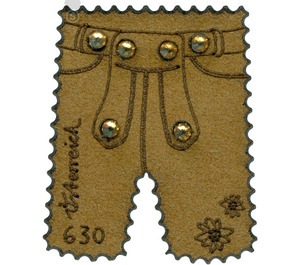strive - Austria / II. Republic of Austria 2015 - 630 Euro Cent
Theme: Devices, Items & Instruments
| Country | Austria / II. Republic of Austria |
| Issue Date | 2015 |
| Face Value | 630.00 |
| Edition Issued | 150,000 |
| Printing Type | laser cutting |
| Stamp Type | Commemorative |
| Item Type | Stamp |
| Chronological Issue Number | 2568 |
| Chronological Chapter | OOS-OE2 |
| SID | 933214 |
| In 90 Wishlists | |
The leather pants Alcantara stamped stamp with 6 Swarovski crystals. The brand is self-adhesive on the entire back, the adhesive surface is covered by a white foil. It is made as a single piece and offered (no backing paper). Alcantara is the trade name of the polyester and polyurethane-based microfiber nonwoven fabric. It is sometimes mistakenly called leather or suede. The fabric was developed in 1970 by Miyoshi Okamoto of the Japanese Toray Industries and brought to market together with the Gruppo ENI. The aim was to develop a textile that could replace the ever-scarce leather by its properties. The material is licensed since 1974 exclusively in an Italian work of Alcantara S. p. A. produced in the Italian city of Terni (Umbria) and used mainly for seat covers in the car industry to simulate a "leather upholstery". The short leather pants Although it is considered to be "typically Tyrolean", it was and still is an original working trousers especially for forest workers throughout the Alpine and Alpine foothills, not only in Austria, but also in neighboring Bavaria, Italy, Switzerland and France used garment. Therefore, it has little in common with "costume", since it is not characteristic of any area, and its cut and appearance vary considerably depending on the landscape. The stamp therefore shows the leather pants in a stylized, idealized form. The crystals applied to the "Hosentürl" and the waistband are a concession to the manufacturer - the Tyrolean company D. Swarovski KG - and are used exclusively for the decoration of this special stamp, of course, have lost nothing on a "real" leather pants. Lederhose - Cloth trousers from the point of view of the costume The contrast Lederhose - cloth pants not only separates the ghosts of male traditional wearers. The fact is that leather pants have become increasingly popular and have invaded traditional costumes (such as the urban area), where it was unknown just a few generations ago. The clothing of the peasant population in the flat country was usually the cloth pants both work and festive clothing. The fabrics for this were mostly made at home and were an affordable material. The shape (knickers or bloomers) varied with the fashion, as the color was black preferred to attract less impurities. The situation was different for the inhabitants of the Alpine region, the mountain and forest region. The leather used in hunting as a hard-wearing material for trousers was used there for centuries, whereby the shapes also adapted to the respective fashions here. The origin of today as folk costume called Lederhose was the Culotte, a tight-fitting court Kniebundhose. Only at the end of the 18th century. She replaced the farmers' usual bloomers. While the urban troupes found their way to long trousers after the French Revolution, the cut among the rural population was seen as practical work trousers for men and sometimes for women. Both the Austrian imperial court (beginning with Archduke Johann to Emperor Franz Joseph I) and the Bavarian Wittelsbacher (King Maximilian II: Prince Regent Luitpold) promoted the national costumes and Lederhosen in particular, which also makes them in the "higher" and urban Circling suddenly acceptable and - but mostly during the hunt or in the "summer freshness" - was worn. The birth of today's lederhosen lederhosen was the 25th of August 1883, when the village schoolmaster Joseph Vogel from Bayrischzell founded a costume club and the founding fathers had new leather pants made. Everyone was horrified. The short leather pants were workwear and not the future costume! The indignation of the city people was great. The church has banned the wearing of leather pants for a short time and the farmers were offended. Nevertheless, the Lederhose has prevailed and after the First World War, she gradually came into fashion throughout the German-speaking world, to be displaced only by the jeans. Nevertheless, the contrast cloth trousers leather pants lasts until the present. ag


